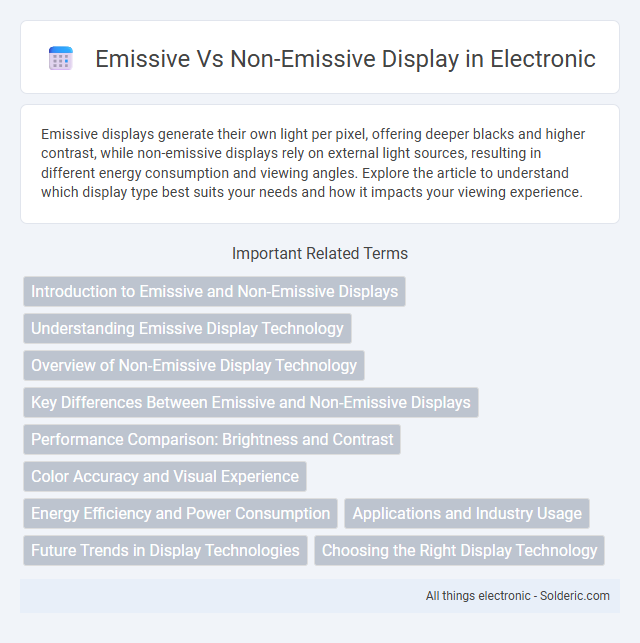Emissive displays generate their own light per pixel, offering deeper blacks and higher contrast, while non-emissive displays rely on external light sources, resulting in different energy consumption and viewing angles. Explore the article to understand which display type best suits your needs and how it impacts your viewing experience.
Comparison Table
| Feature | Emissive Display | Non-Emissive Display |
|---|---|---|
| Light Source | Self-emitting pixels | Requires external backlight |
| Contrast Ratio | High (true blacks) | Lower (backlight bleed) |
| Power Consumption | Lower in dark mode | Constant due to backlighting |
| Viewing Angles | Wide and consistent | Limited and color shifting |
| Response Time | Fast, ideal for motion | Slower response time |
| Color Accuracy | Superior color vibrancy | Dependent on backlight quality |
| Lifespan | Shorter due to organic materials | Longer lifespan |
| Examples | OLED, MicroLED | LCD, LED LCD |
Introduction to Emissive and Non-Emissive Displays
Emissive displays generate light directly from each pixel, using technologies like OLED and microLED to produce high contrast ratios and vibrant colors. Non-emissive displays, such as LCDs, rely on backlighting to illuminate pixels, resulting in lower contrast and energy efficiency. Understanding the fundamental difference in light emission is crucial for selecting the appropriate display type for specific applications.
Understanding Emissive Display Technology
Emissive display technology generates light directly from each pixel using materials like organic compounds in OLEDs or inorganic materials in microLEDs, resulting in higher contrast ratios and vibrant colors. These displays enable deeper blacks since individual pixels can turn off completely, unlike non-emissive LCDs that rely on backlighting and liquid crystals to modulate light transmission. Key advantages include energy efficiency and faster response times, making emissive displays ideal for high-performance screens in smartphones, TVs, and wearables.
Overview of Non-Emissive Display Technology
Non-emissive display technology primarily relies on external light sources to illuminate the screen, as seen in liquid crystal displays (LCDs) that use backlighting. These displays manipulate light through liquid crystals or other materials to create images, offering energy efficiency and longer lifespan compared to emissive counterparts. Common applications include smartphones, monitors, and televisions where consistent brightness and reduced power consumption are critical.
Key Differences Between Emissive and Non-Emissive Displays
Emissive displays, such as OLEDs and microLEDs, produce light directly from each pixel, resulting in higher contrast, deeper blacks, and better energy efficiency in dark scenes. Non-emissive displays, like LCDs, rely on a backlight to illuminate pixels, which can lead to lower contrast ratios and less vibrant colors. Key differences include power consumption, viewing angles, and color accuracy, with emissive displays generally offering superior performance in these areas.
Performance Comparison: Brightness and Contrast
Emissive displays, such as OLEDs, emit their own light, allowing for higher brightness levels and perfect blacks, resulting in superior contrast ratios compared to non-emissive displays like LCDs, which rely on backlighting and struggle to achieve true black. This intrinsic light emission enables emissive screens to deliver more vibrant colors and improved visibility in various lighting conditions. Non-emissive displays typically show lower contrast and reduced brightness uniformity due to their dependence on external light sources.
Color Accuracy and Visual Experience
Emissive displays, such as OLED screens, produce light directly from each pixel, resulting in superior color accuracy and more vibrant visuals compared to non-emissive displays like LCDs, which rely on backlighting. This direct pixel illumination enhances contrast ratios and deep blacks, significantly improving the overall visual experience. Non-emissive displays often struggle with color consistency and lower contrast, leading to less vivid and less accurate image reproduction.
Energy Efficiency and Power Consumption
Emissive displays, such as OLED and microLED, generate their own light, enabling individual pixel control that significantly reduces power consumption by turning off pixels for black or dark scenes. Non-emissive displays like LCDs require a constant backlight, consuming more energy regardless of screen content, making them less energy efficient. If you prioritize energy efficiency and lower power usage, choosing an emissive display can extend battery life in mobile devices and decrease electricity costs for larger screens.
Applications and Industry Usage
Emissive displays, such as OLED and MicroLED, are widely used in smartphones, wearable technology, and high-end televisions due to their vibrant colors, deep blacks, and energy efficiency. Non-emissive displays like LCDs dominate applications requiring large screen sizes and outdoor readability, including computer monitors, digital signage, and automotive dashboards. Your choice between emissive and non-emissive technologies depends on factors like power consumption, image quality, and specific industry requirements.
Future Trends in Display Technologies
Emerging trends in display technologies highlight a strong shift toward emissive displays such as OLED and MicroLED due to their superior contrast ratios, faster response times, and energy efficiency compared to non-emissive alternatives like LCDs. Advancements in emissive materials and quantum dot technology are driving the development of flexible, transparent, and ultra-high-resolution displays, which are critical for next-generation applications in augmented reality and wearable devices. Non-emissive displays continue to evolve with improvements in backlighting and energy-saving modes, but the future dominance of emissive technology is evident in commercial and consumer electronics markets.
Choosing the Right Display Technology
Selecting the right display technology hinges on understanding the core differences between emissive and non-emissive displays. Emissive displays such as OLED and MicroLED produce their own light, offering superior contrast, deeper blacks, and energy efficiency ideal for high-definition screens and flexible devices. Non-emissive displays like LCD rely on backlighting, providing longer lifespan and cost-effectiveness, making them suitable for bright ambient environments and budget-conscious applications.
Emissive vs Non-Emissive Display Infographic

 solderic.com
solderic.com